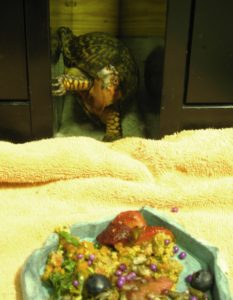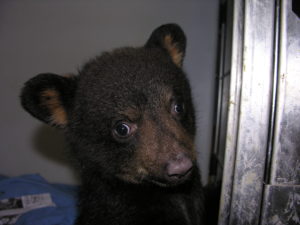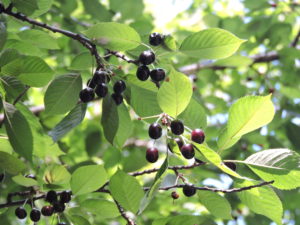Risky Plants
I am not an expert on toxic plants, but I will attempt to articulate my current understanding of the risks readers should be aware of. You should consult with your veterinarian about any plant you have further concerns about. Or make the effort to find a library copy of Toxic Plants of North America, 2nd Edition, by Burrows and Tyrl (2013).
Plant toxicity is a very complex topic. Many factors go into whether a plant is toxic in any given instance. Ultimately, rehabbers have to take responsibility for the risks of any food— commercial or wild—which they feed to their animals.
While I am at it, I’ll stick in my entire website disclaimer right here:
- Dear animal-loving people: I am an amateur who is doing the best I can to find science-based information from people who are experts in wildlife diets, and present that info to you in order to help you decide how to best care for wild animals in your care. I am a learner, perhaps just as you are. You now know that you take full legal responsibility for whatever decisions you make regarding using wild foods in your own wildlife rehabilitation practice. Think clearly for yourself and make your own decisions, seek more information to clarify any unanswered questions or to seek the input of a licensed veterinarian or toxicologist should you choose to consult one. As stated elsewhere on this site, none of the info presented is implied to apply to wild foraging as human foods in any way. I wish you only the best for your practice and all the wonderful wild animals in your care.~
The most general impression I can offer is that when it comes to toxicity, the greatest hidden threats that could surprise you would most likely be with cut browse and greens. People are generally leery and cautious with unfamiliar fruits– having been well trained since childhood that “wild berries are poisonous” (and some are.)
There are no blanket, hard and fast, black and white statements that can be made when it comes to plant toxicity. Nonetheless, generalities may help you find your personal comfort range in exploring and incorporating some wild foods into your rehab diets.

About the Cautions in the Database
When you search by plant in this site’s database, if there is a warning, it will show up right below the plant name. In most cases, I have written the warnings specifically for the PART of the plant listed. So, for example, a fruit of Plant A may show no warning, but there could still be risks for Plant A’s roots, and the roots may or may not be listed in this database.The cautions listed are for the eastern half of the USA. So, the same plants in the western USA or in Europe, for example, may have toxicities associated with them. Be aware of that.
I generally have tried to list the worst risks I have found for any given genus; individual species within the genus may or may not be as toxic as the caution indicates.
When you search by animal, you will generate a list of wild plant foods the animal is known to eat. A symbol is displayed to the right of the food plant listed if there are cautions of any sort you should check.
Generally, this site does not list human ingestion toxicity info, because this site is not about foraging for human foods.
Toxicity Overview
We have two things to consider: plants that are dangerous to humans and plants that are dangerous to animals.
Some of the caution terms used on this site and what they mean:
- Contact Dermatitis means the plant has been known to cause a skin irritation in some or many humans who physically touch the plant.
- Allergen means that some parts of the plant has triggered some sort of allergic reactions in some people. If I have listed it, it is because it is a common allergen for many people.
- Toxic The term “toxic” on this site is used interchangeably with the work “poisoned”. In lay speech, “poison” seems to indicate something that is wholly bad, though whereas toxic be more a nuanced term. Nonetheless, I use both terms. Toxic reactions may be acute reactions or accumulation of toxins over time which may sicked animals or killed animals. The toxicity:
- may have occurred in specific species’ of animal(s) or across a wide range of animals;
- may have involved only one or even all species of the plants in the genera;
- may only have only occurred when certain quantities of the plant were ingested;
- may have occurred when ingesting only certain parts of the plant—such as roots, or seeds;
- may have only occurred under certain environmental conditions;
- may have occurred in one plant but not the plant growing next to it.
- Livestock Poisonings
- When I use the term livestock, it generally means an unspecified variety of farm mammals species.
- According to Dr. Peach Van Wick, Wildlife Research Fellow at the Wildlife Center of Virginia, there are similarities of physiology that may help translate livestock reactions to wildlife. The most data and the most research of plant toxicities has happened on commercially important animals and pets, not wildlife.
- Poisonings to horses may have a similar effect on rabbits.
- Poisonings to goats and cows (ruminants) may have similar effects on deer.
- Domestic dog poisonings may generalize to fox or coyotes
In addition, here are some Wikipedia descriptions of some of the veterinary medical syndromes you may see listed in the caution statements.
Ergotism https://en.wikipedia.org/wiki/Ergotism
“Ergotism is the effect of long-term ergot poisoning, traditionally due to the ingestion of the alkaloids produced by the Claviceps purpurea fungus that infects rye and other cereals, and more recently by the action of a number of ergoline-based drugs. It is also known as ergotoxicosis, ergot poisoning and Saint Anthony’s Fire.”
Endophytic fungus https://en.wikipedia.org/wiki/Endophyte
“An endophyte is an endosymbiont, often a bacterium or fungus, that lives within a plant for at least part of its life cycle without causing apparent disease. Endophytes are ubiquitous and have been found in all species of plants studied to date; however, most of the endophyte/plant relationships are not well understood.”
Grass tetany https://en.wikipedia.org/wiki/Grass_tetany
“Grass tetany or hypomagnesemic tetany, also known as grass staggers and winter tetany, is a metabolic disease involving magnesium deficiency, which can occur in such ruminant livestock as beef cattle, dairy cattle and sheep, usually after grazing on pastures of rapidly growing grass, especially in early spring.
Hypomagnesaemia is a rare but important cause of sudden death in ruminants.
Adult cattle and sheep have no effective tissue stores of magnesium, so lactating animals are at risk of developing a deficiency. The risk is increased when they are grazing pasture, especially in Spring and Autumn when the absorption of magnesium is influenced by factors including: high levels of potassium, nitrogen and moisture content and low levels of sodium.”
Photosensitization http: www.wikivet.net
“Photosensitization is an abnormal reaction of the skin to sunlight due to the presence of a photodynamic agent in the dermis. It is primarily a condition of sheep, cattle and horses but other species may also be susceptible.
Plants may induce either primary or secondary photosensitization:
1) primary photosensitization directly from chemicals contained in ingested plants
2) secondary photosensitization from plant-associated damage to the liver (hepatogenous).”
Stringhalt https://en.wikipedia.org/wiki/Stringhalt
“Stringhalt is a sudden flexion of one or both hind legs in the horse, most easily seen while the horse is walking or trotting. It is most evident when the horse is backing up slowly, turning on the affected leg, or suddenly frightened. It can involve one or both hind legs of the horse. It is a spasmodic contraction of the lateral extensor tendons of the hind legs. There are four forms of stringhalt, one of which is Australian stringhalt: Hypochaeris radicata is the suspected cause.”

Animal Safety
It would be great if there was a sharp, clean dividing line between edible plants and toxic plants, but in fact, there is a ridiculous amount of overlap. Some plants that are toxic if eaten in great quantities may be totally palatable in lesser quantities. If you are a coffee drinker, you know this. Medical toxicologist at NOW Foods, Sandra James-Yi, DVM, PhD, DABT, reminded me of this. There is an oft-repeated saying around this: “the dose makes the poison.”
Plants that are safe and good animal food can also become toxic under certain conditions such as soil or weather conditions, or at certain times of year.
Rehabbers can totally avoid plants with any stated risk– and some of you may choose to do just that– which is fine. It can be simultaneously true that a plant is both eaten by wildlife AND that the plant can be toxic. So you have to decide the risk vs. benefit of offering any given food.
The “Precautionary Principle” is a guideline of how to present potentially harmful information when thorough scientific understanding is still lacking. “The principle implies that there is a social responsibility to protect the public from exposure to harm, when scientific investigation has found a plausible risk. These protections can be relaxed only if further scientific findings emerge that provide sound evidence that no harm will result. (Wikipedia)” Since not every species in this database has been exhaustively studied for toxicology, we must assume there could be risks across any genera where one species has toxicities.
As we have noted elsewhere, all wild animals in rehab are under stress. Stress, illness and injury can all change an animal’s appetite and behavior. Combining stress with the restricted range of dietary choices in captivity creates a situational set-up for an animal. They are less likely to self-regulate eating or to avoid a toxic plant as effectively as the animal would in the wild. More of that risk management falls on the rehabber.
However, there are a few cases of plants documented to be eaten by animals that I felt were so dangerous, and I removed those from this database. Like cherry browse.

Down the Road:
Plant toxicology is a learning edge for me. My goal is to continue to learn about the plants and their risks associated with the database of this website. I believe in this first offering, I have notated the worst and most general risks.
